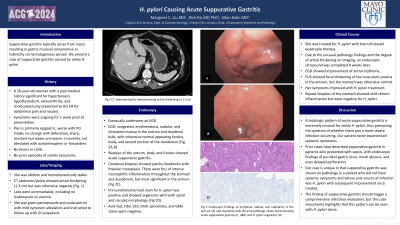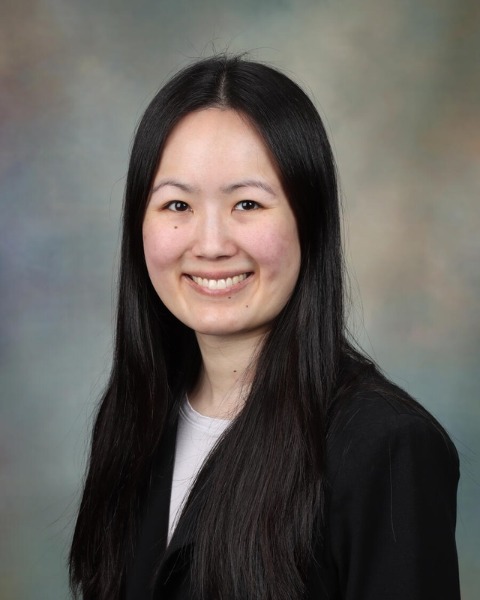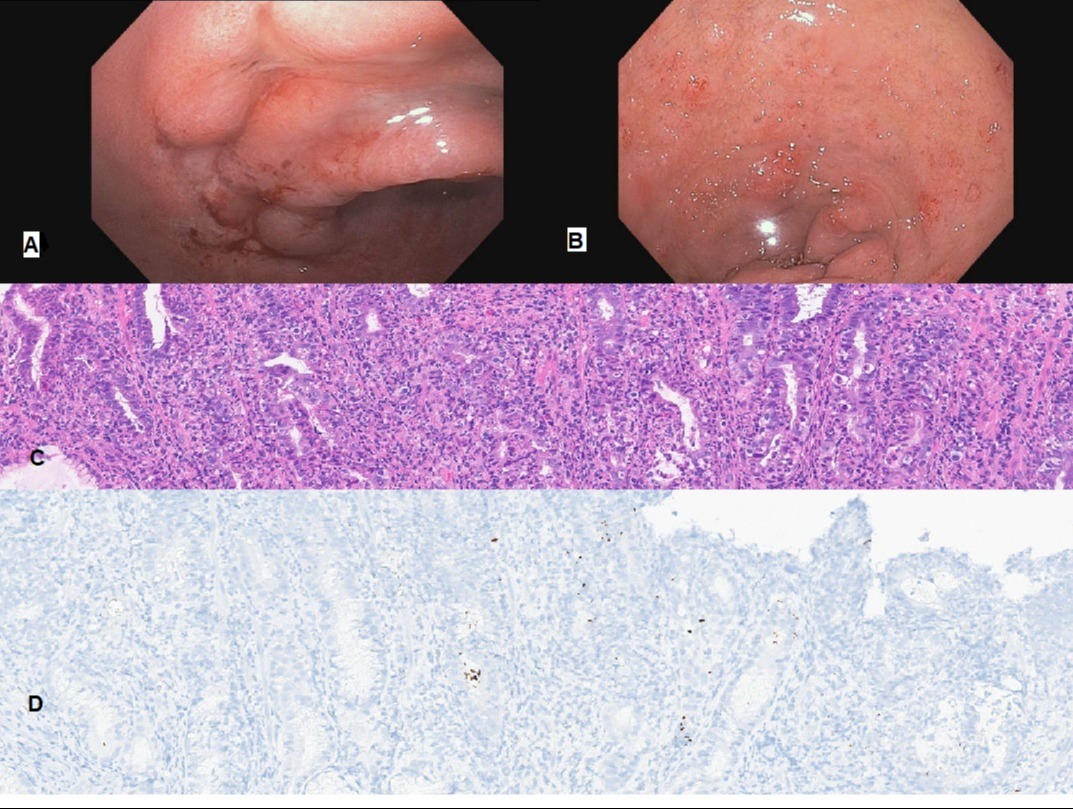Sunday Poster Session
Category: Stomach
P1626 - H. pylori Infection Causing Acute Suppurative Gastritis
Sunday, October 27, 2024
3:30 PM - 7:00 PM ET
Location: Exhibit Hall E

Has Audio

Margaret C. Liu, MD
Mayo Clinic
Scottsdale, AZ
Presenting Author(s)
Margaret C. Liu, MD, Rish Pai, MD, PhD, Allon Kahn, MD
Mayo Clinic, Scottsdale, AZ
Introduction: Suppurative gastritis typically arises from injury resulting in gastric mucosal compromise or indirectly via hematogenous spread. We present a case of suppurative gastritis caused by solely H. pylori.
Case Description/Methods: A 56-year-old woman presented for abdominal pain. CT abdomen/pelvis showed antral thickening (1.3 cm) but was otherwise negative. Labs were unremarkable. She was given pantoprazole and ondansetron with mild symptom alleviation. She re-presented 1 week later with similar symptoms and underwent an upper endoscopy, which showed congested, erythematous, nodular, and ulcerated mucosa in the antrum and duodenal bulb, with otherwise normal appearing fundus, body, and second portion of the duodenum (Fig 1). Biopsies of the antrum, body, and fundus showed acute suppurative gastritis. Duodenal biopsies showed patchy duodenitis with foveolar metaplasia. There were foci of intense neutrophilic inflammation throughout the stomach and duodenum, but most significant in the antrum (Fig 1). Immunohistochemical stain for H. pylori was positive and showed organisms with both spiral and coccoid morphology. Acid-fast, HSV, VZV, CMV, spirochete, and GMS stains were negative. She was treated for H. pylori with bismuth-based quadruple therapy. Due to the unusual pathology findings and the degree of antral thickening on imaging, an endoscopic ultrasound was completed 8 weeks later. There was improvement of antral erythema, and ultrasound showed focal thickening of the muscularis propria in the antrum, but the stomach was otherwise normal. Her symptoms improved with H. pylori treatment. Repeat biopsies of the stomach showed mild chronic inflammation but were negative for H. pylori.
Discussion: A histologic pattern of acute suppurative gastritis is extremely unusual for solely H. pylori, thus prompting the question of whether there was a more severe infection occurring. Our patient never experienced systemic symptoms. Prior cases have described suppurative gastritis in patients who presented with sepsis, with endoscopic findings of purulent gastric ulcer, mural abscess, and even delayed perforation. Our case is unique in that suppurative gastritis was shown on pathology in a patient who did not have systemic symptoms and whose only source of infection was H. pylori with subsequent improvement once treated. The finding of suppurative gastritis should trigger a comprehensive infectious evaluation, but this case importantly highlights that this pattern can be seen with H. pylori alone.

Disclosures:
Margaret C. Liu, MD, Rish Pai, MD, PhD, Allon Kahn, MD. P1626 - <i>H. pylori</i> Infection Causing Acute Suppurative Gastritis, ACG 2024 Annual Scientific Meeting Abstracts. Philadelphia, PA: American College of Gastroenterology.
Mayo Clinic, Scottsdale, AZ
Introduction: Suppurative gastritis typically arises from injury resulting in gastric mucosal compromise or indirectly via hematogenous spread. We present a case of suppurative gastritis caused by solely H. pylori.
Case Description/Methods: A 56-year-old woman presented for abdominal pain. CT abdomen/pelvis showed antral thickening (1.3 cm) but was otherwise negative. Labs were unremarkable. She was given pantoprazole and ondansetron with mild symptom alleviation. She re-presented 1 week later with similar symptoms and underwent an upper endoscopy, which showed congested, erythematous, nodular, and ulcerated mucosa in the antrum and duodenal bulb, with otherwise normal appearing fundus, body, and second portion of the duodenum (Fig 1). Biopsies of the antrum, body, and fundus showed acute suppurative gastritis. Duodenal biopsies showed patchy duodenitis with foveolar metaplasia. There were foci of intense neutrophilic inflammation throughout the stomach and duodenum, but most significant in the antrum (Fig 1). Immunohistochemical stain for H. pylori was positive and showed organisms with both spiral and coccoid morphology. Acid-fast, HSV, VZV, CMV, spirochete, and GMS stains were negative. She was treated for H. pylori with bismuth-based quadruple therapy. Due to the unusual pathology findings and the degree of antral thickening on imaging, an endoscopic ultrasound was completed 8 weeks later. There was improvement of antral erythema, and ultrasound showed focal thickening of the muscularis propria in the antrum, but the stomach was otherwise normal. Her symptoms improved with H. pylori treatment. Repeat biopsies of the stomach showed mild chronic inflammation but were negative for H. pylori.
Discussion: A histologic pattern of acute suppurative gastritis is extremely unusual for solely H. pylori, thus prompting the question of whether there was a more severe infection occurring. Our patient never experienced systemic symptoms. Prior cases have described suppurative gastritis in patients who presented with sepsis, with endoscopic findings of purulent gastric ulcer, mural abscess, and even delayed perforation. Our case is unique in that suppurative gastritis was shown on pathology in a patient who did not have systemic symptoms and whose only source of infection was H. pylori with subsequent improvement once treated. The finding of suppurative gastritis should trigger a comprehensive infectious evaluation, but this case importantly highlights that this pattern can be seen with H. pylori alone.

Figure: Fig 1 Endoscopic findings of erythema, edema, and nodularity in the antrum (A) and duodenal bulb (B) and pathology slides demonstrating acute suppurative gastritis (C, H&E) and H. pylori organisms (D)
Disclosures:
Margaret Liu indicated no relevant financial relationships.
Rish Pai: AbbVie – Consultant. Alimentiv – Consultant. Allergan – Consultant. Eli Lilly and Company – Consultant. Genentech – Consultant. PathAI – Consultant.
Allon Kahn: MiMedx Inc – Consultant.
Margaret C. Liu, MD, Rish Pai, MD, PhD, Allon Kahn, MD. P1626 - <i>H. pylori</i> Infection Causing Acute Suppurative Gastritis, ACG 2024 Annual Scientific Meeting Abstracts. Philadelphia, PA: American College of Gastroenterology.
